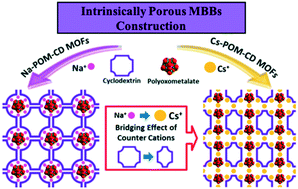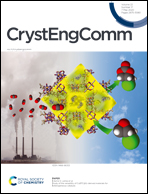Intrinsically porous molecular building blocks for metal organic frameworks tailored by the bridging effect of counter cations†
Abstract
Predesigned organic linkers have dominated the world of pillared metal organic frameworks to tune the overall morphology, size, and performance of this class of materials. However, the porosity of the framework was never guaranteed due to possible assembly interpenetration and ligand self-closure. Here, we present an interesting construction strategy employing macrocyclic molecular building blocks (MBBs) with intrinsic voids to boost the porosity and host-guest interactions of these hybrid frameworks. In situ co-crystallization of the isolated polyoxomolybdates (P2Mo5O23) and cyclodextrins (CDs) has resulted in seven POM–CD MOFs following this strategy. The bridging effect dictated by the size of counter cations (Na+, K+, and Cs+) can readily tune the structural and performance features of the end frameworks including pore morphology and water stability. This strategy paves the way for the precise design of customized porous materials with built-in macrocyclic hosts for improved molecular recognition of prospective guest molecules.

- This article is part of the themed collection: Introducing the CrystEngComm Advisory Board and their research


 Please wait while we load your content...
Please wait while we load your content...